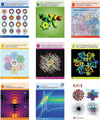issue contents
November 2021 issue

Cover illustration: The exploration of novel magnetic materials requires characterization methods capable of displaying atomic scale behaviour. The multislice method is used in the simulation of high-resolution images in transmission electron microscopy; however the inclusion of magnetic effects in this method is challenging, particularly for larger systems. Lyon & Rusz [Acta Cryst. (2021). A77, 509–518] present a parameterized magnetism approach which is able to describe the effects of magnetism in large crystals to a good degree of accuracy. The cover image shows the logarithm of the relative ratio of the squared amplitude of the DFT and parameterized magnetism exit wavefunctions for body-centred cubic Fe.
advances
research papers
 access
access

foundations
research papers
 access
access access
access

international union of crystallography



 journal menu
journal menu




























